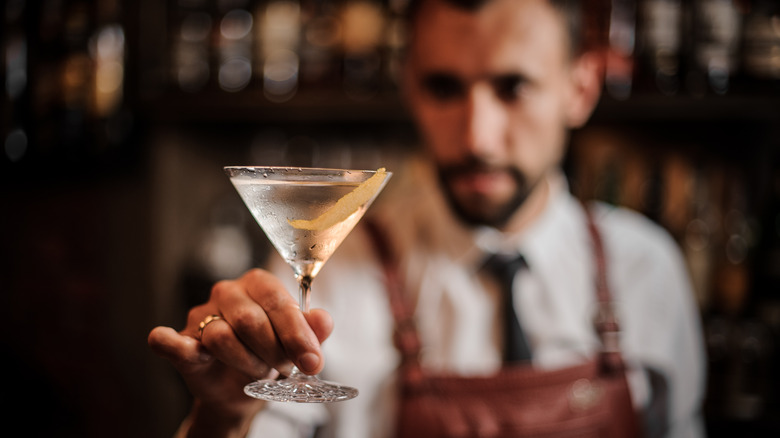Should A Martini Be Shaken Or Stirred?
A martini is one of those classic cocktails that brings with it a set of unwritten rules. There tend to be strong opinions surrounding this strong drink: While there's no wrong martini order, there's a right way to go about ordering one. Vodka or gin? Dry or wet? Do you want it dirty? What's your garnish of choice? And finally, the age-old question: shaken or stirred?
Some prefer their martini with the traditional gin for an added layer of botanical flavor; others opt for vodka for a crisp and clean taste. Some stick to wet, others up the vermouth ratio to make it dry. The dirty martini crowd likes it clouded with olive juice for extra brine. And then there are plenty of garnishes to choose from — olives, lemon twist, or cocktail onions. But the shaken or stirred question brings us back to those unwritten rules.
Any bartender will tell you that just like there's a masterful way to order a martini, there's also a proper way to make one. This question of the chilling method has shaken and stirred up a heated debate in the world of mixology, with valid arguments on both sides. So what's the right way to make a martini — to shake or to stir?
The verdict is in
In the end, it does come down to personal preference (after all, James Bond didn't completely ruin the martini by ordering his "shaken not stirred," and some simply prefer the aerated, ice-chipped martini that shaking produces). But if we're considering the martini in its most traditional sense — two parts gin, one part dry vermouth, garnished with an olive or a lemon twist and served up — the so-called purists out there believe that stirring is the right way to go.
Why? Well, one of those unwritten rules that apply here is the fundamental law by which bartenders abide: Spirit-forward cocktails (made up of alcohol-based ingredients only) are meant to be stirred, while cocktails that incorporate other elements outside of alcohol (like egg whites, juice, or cream) should be shaken (via Punch). That's because the gentle method of stirring keeps the alcohol silky and smooth, making the drink cohesive without messing up the texture of the spirits — which are meant to be sipped and savored.
Another reason is that many believe shaking a martini with ice dilutes the cocktail too much, as Alcohol Professor points out — making it cloudy, changing its flavor, and taking away from what should be a stiff, spirit-forward experience. Some even go so far as to say that it bruises the gin, making it more bitter. These purists say stirring will do the job of chilling the martini to its desired temperature without watering it down and doing an injustice to this spirit-filled cocktail.
But wait — there's also a right way to stir
So many martini rules, right? But if you're one of the purists and want your martini stirred, this one's important. While shaking a martini is pretty straightforward and will quickly and effectively chill the cocktail to ice cold (which is the point), stirring can be a bit more tricky because the aim is to reach a specific level of chill-versus dilution.
As Cocktail Crate explains, it's crucial to be consistent when stirring — many factors can mess up that consistency. For example, the longer you stir, the more diluted your drink will become, and the faster you stir, the faster your drink will be diluted. And the size of the ice is essential: the more surface area that the ice covers, the quicker the drink will chill (and, as a result, dilute). And even the type of glass you use makes a big difference, as a glass chilled in the freezer will get you a head start on chilling and ultimately dilute the drink less.
Simply Recipes recommends filling your mixing glass halfway with ice and stirring "smoothly and quickly," experimenting with 15-, 20-, and 30-second stirs to find your ideal martini temperature and taste. Then strain into a pre-chilled martini glass, garnish to your liking, and enjoy.


